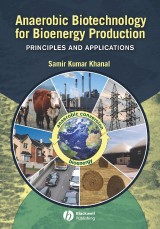Details

Anaerobic Biotechnology for Bioenergy Production
Principles and Applications1. Aufl.
|
241,99 € |
|
| Verlag: | Wiley-Blackwell |
| Format: | |
| Veröffentl.: | 03.03.2009 |
| ISBN/EAN: | 9780813804569 |
| Sprache: | englisch |
| Anzahl Seiten: | 320 |
DRM-geschütztes eBook, Sie benötigen z.B. Adobe Digital Editions und eine Adobe ID zum Lesen.
Beschreibungen
Anaerobic biotechnology is a cost-effective and sustainable means of treating waste and wastewaters that couples treatment processes with the reclamation of useful by-products and renewable biofuels. This means of treating municipal, agricultural, and industrial wastes allows waste products to be converted to value-added products such as biofuels, biofertilizers, and other chemicals. <i>Anaerobic Biotechnology for Bioenergy Production: Principles and Applications </i>provides the reader with basic principles of anaerobic processes alongside practical uses of anaerobic biotechnology options. This book will be a valuable reference to any professional currently considering or working with anaerobic biotechnology options.
CONTRIBUTORS, xi <p>PREFACE, xiii</p> <p><b>1</b> <b>OVERVIEW OF ANAEROBIC BIOTECHNOLOGY, 1<br /> </b><i>Samir Kumar Khanal</i></p> <p>1.1 Anaerobic Biotechnology and Bioenergy Recovery, 1</p> <p>1.2 Historical Development, 3</p> <p>1.3 Importance of Anaerobic Biotechnology in Overall Waste Treatment, 5</p> <p>1.4 Definition and Principle of Anaerobic Processes, 6</p> <p>1.5 Important Considerations in Anaerobic Biotechnology, 8</p> <p>1.6 Merits of Anaerobic Biotechnology, 15</p> <p>1.7 Limitations of Anaerobic Process, 22</p> <p>References, 25</p> <p><b>2 MICROBIOLOGY AND BIOCHEMISTRY OF ANAEROBIC BIOTECHNOLOGY, 29<br /> </b><i>Samir Kumar Khanal</i></p> <p>2.1 Background, 29</p> <p>2.2 Organics Conversion in Anaerobic Systems, 29</p> <p>2.3 Process Microbiology, 32</p> <p>References, 41</p> <p><b>3 ENVIRONMENTAL FACTORS, 43<br /> </b><i>Samir Kumar Khanal</i></p> <p>3.1 Background, 43</p> <p>3.2 Temperature, 43</p> <p>3.3 Operating pH and Alkalinity, 47</p> <p>3.4 Nutrients, 55</p> <p>3.5 Toxic Materials, 56</p> <p>3.6 Redox Potential or Oxidation–Reduction Potential, 59</p> <p>References, 61</p> <p><b>4 KINETICS AND MODELING IN ANAEROBIC PROCESSES, 65<br /> </b><i>Keshab Raj Sharma</i></p> <p>4.1 Background, 65</p> <p>4.2 Basic Elements, 66</p> <p>4.3 Stepwise Approach to Modeling, 69</p> <p>4.4 Modeling of pH Change, 79</p> <p>4.5 Modeling of Energy Generation, 87</p> <p>References, 92</p> <p><b>5 ANAEROBIC REACTOR CONFIGURATIONS FOR BIOENERGY PRODUCTION, 93<br /> </b><i>Samir Kumar Khanal</i></p> <p>5.1 Background, 93</p> <p>5.2 Strategies for Decoupling HRT and SRT, 93</p> <p>5.3 Classification of Anaerobic Bioreactors, 94</p> <p>5.4 Membrane Technology for Syngas Fermentation to Ethanol, 112</p> <p>References, 114</p> <p><b>6 MOLECULAR TECHNIQUES IN ANAEROBIC BIOTECHNOLOGY: APPLICATION IN BIOENERGY GENERATION, 115<br /> </b><i>Srisuda Dhamwichukorn</i></p> <p>6.1 Background, 115</p> <p>6.2 Molecular Techniques in Anaerobic Biotechnology, 115</p> <p>6.3 Fundamentals of Molecular Techniques, 116</p> <p>6.4 Phylogenetic Analysis, 117</p> <p>6.5 Molecular Techniques for Microbial Community Structure Analysis: DNA Fingerprinting, Clone Library, and Fluorescent in Situ Hybridization, 118</p> <p>6.6 Molecular Techniques for Functional Analysis, 121</p> <p>6.7 Nucleic Acid Extraction of Anaerobic Cells/Isolates and Sludge, 123</p> <p>6.8 Molecular Techniques for Structure and Function Analysis, 123</p> <p>6.9 Postgenomic Approaches for Bioenergy Research, 128</p> <p>References, 130</p> <p><b>7 BIOENERGY RECOVERY FROM SULFATE-RICH WASTE STREAMS AND STRATEGIES FOR SULFIDE REMOVAL, 133<br /> </b><i>Samir Kumar Khanal</i></p> <p>7.1 Background, 133</p> <p>7.2 Sulfate-Reducing Bacteria, 133</p> <p>7.3 High-Strength Sulfate-Rich Wastewater, 135</p> <p>7.4 Methane Recovery from High-Strength Sulfate-Laden Wastewater, 135</p> <p>7.5 Important Considerations in Treatment and Methane Recovery from High-Strength Sulfate-Laden Wastewater, 137</p> <p>7.6 Interactions between MPB and SRB, 143</p> <p>7.7 Sulfide Removal, 149</p> <p>References, 157</p> <p><b>8 BIOENERGY GENERATION FROM RESIDUES OF BIOFUEL INDUSTRIES, 161<br /> </b><i>Samir Kumar Khanal</i></p> <p>8.1 Background, 161</p> <p>8.2 Bioethanol Feedstocks, 162</p> <p>8.3 Biodiesel Feedstocks, 163</p> <p>8.4 Ethanol Production, 163</p> <p>8.5 Thin Stillage Characterization, 171</p> <p>8.6 Cassava-Based Ethanol Production, 183</p> <p>8.7 Cellulose-Based Ethanol Production, 185</p> <p>8.8 Bioenergy Recovery from Crude Glycerin, 186</p> <p>References, 187</p> <p><b>9 BIOHYDROGEN PRODUCTION: FUNDAMENTALS, CHALLENGES, AND OPERATION STRATEGIES FOR ENHANCED YIELD, 189<br /> </b><i>Samir Kumar Khanal</i></p> <p>9.1 Background, 189</p> <p>9.2 Biological Hydrogen Production, 190</p> <p>9.3 Microbiology of Dark Fermentation, 191</p> <p>9.4 Hydrogen Production Pathway through Dark Fermentation, 192</p> <p>9.5 Suppression of Hydrogen Consumers, 196</p> <p>9.6 Hydrogen Yield, 199</p> <p>9.7 Important Considerations in Biohydrogen Production, 200</p> <p>9.8 Limitations of Dark Fermentation and Potential Remedial Options, 210</p> <p>9.9 Technoeconomic Analysis of Hydrogen Fermentation, 213</p> <p>References, 215</p> <p><b>10 MICROBIAL FUEL CELL: NOVEL ANAEROBIC BIOTECHNOLOGY FOR ENERGY GENERATION FROM WASTEWATER, 221<br /> </b><i>Hong Liu</i></p> <p>10.1 Background, 221</p> <p>10.2 How Does a Microbial Fuel Cell Work?, 222</p> <p>10.3 Stoichiometry and Energetics, 223</p> <p>10.4 Electrochemically Active Microbes and Electron Transfer Mechanisms, 225</p> <p>10.5 Evaluation of MFC Performance, 228</p> <p>10.6 MFC Designs and Electrode Materials, 231</p> <p>10.7 Operational Factors Affecting MFC Performance, 239</p> <p>10.8 Opportunities and Challenges for MFCs in Wastewater</p> <p>Treatment, 242</p> <p>References, 243</p> <p><b>11 PRETREATMENT OF HIGH-SOLIDS WASTES/RESIDUES TO ENHANCE BIOENERGY RECOVERY, 247<br /> </b><i>Santha Harikishan</i></p> <p>11.1 Background, 247</p> <p>11.2 Efficiency of Sludge Pretreatment, 248</p> <p>11.3 Ultrasound Pretreatment, 250</p> <p>11.4 Chemical and Physical Pretreatment, 257</p> <p>11.5 Thermal Hydrolysis, 261</p> <p>11.6 Impact of Improved Digestibility on Overall Process</p> <p>Economics, 264</p> <p>References, 264</p> <p><b>12 BIOGAS PROCESSING AND UTILIZATION AS AN ENERGY SOURCE, 267<br /> </b><i>Santha Harikishan</i></p> <p>12.1 Background, 267</p> <p>12.2 Biogas Production, 267</p> <p>12.3 Factors Affecting Digester Gas Production, 269</p> <p>12.4 Biogas Composition, 270</p> <p>12.5 Biogas Impurities, 272</p> <p>12.6 Biogas Cleaning for Effective Utilization, 274</p> <p>12.7 Biogas Utilization, 279</p> <p>12.8 Future of Biogas as a Renewable Resource, 290</p> <p>References, 291</p> <p><b>INDEX, 293</b></p>
<b>Samir Kumar Khanal, PhD, P.E. </b>is an Assistant Professor in the Department of Molecular Biosciences and Bioengineering at the University of Hawaii-Manoa.
<i>Anaerobic Biotechnology for Bioenergy Production: Principles and Applications </i>provides the reader with basic principles of anaerobic processes alongside practical uses of anaerobic biotechnology. Anaerobic biotechnology is a cost-effective and sustainable means of treating waste and wastewaters that couples treatment processes with the reclamation of useful by-products and renewable biofuels. This book will be a valuable reference to any professional currently considering or working with anaerobic biotechnology options.


















